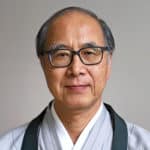What is Zen?
History
The Japanese word Zen (Chinese Chan) comes from the Sanskrit word dhjana and means "deep inner contemplation". The practice of Zen was especially cultivated in the Buddhist tradition of Mahayana in ancient China as a way to directly grasp the truth.

The heyday of Zen Buddhism in ancient China extended from about the 8th to the 12th century. Five schools – Sôtô, Rinzai, Unmon, Igyô, Hôgen – crystallized as the main currents during this period. In the 12th and 13th centuries, this Buddhist movement reached Japan. The Sôtô and Rinzai Schools in particular continued to develop there.

In the west
In the 20th century, Zen became more and more known in the Western world. Initially, Zen attracted attention in the sense of a philosophy. But zazen as a form of practice, coming mainly from Japan, was also taken up in the 1960s and 70s, in America and Europe, where it has remained alive ever since.
In Germany, Zen was seen less as a "religion" and more as a cross-denominational, universal way of practicing. In times of spiritual, social and ecological upheaval, this form of practice enables practitioners to center themselves and deeply experience what our "being" fundamentally is.


What is Sanbôzen?
History
The school of Zen represented at Sanbo Zendo Weyarn is called Sanbôzen. The Japanese word means "Zen of the Three Treasures", the Three Treasures representing Buddha, Dharma and Sangha. This Zen school has been an officially recognized Zen community in Japan since 1954. Grown out of the long tradition of the Sôtô School, it took over the central element of the Rinzai School, the koan training, and developed it further in its own way.

The headquarters of the Sanbôzen is the San'un Zendo, the "Practice Hall of the Three Clouds" in Kamakura/Japan. In recent decades, the Zen practice of Sanbôzen has spread worldwide. The international network Sanbôzen International (SZI) takes this development into account.

Lay movement
Sanbôzen is not subject to the traditional temple system within which Zen has been practiced in China and Japan for centuries. We are a lay community. Our concern is to provide a framework for practice in harmony with everyday life in today's world.
Download
Here, the abbot of Sanbôzen, Yamada Ryôun, talks about the Kenshukai (continuing education seminar for Sanbôzen Zen teachers) held at the Domicilium in the summer of 2018.
What forms of Zen practice are there?
Introduction
In the Sanbôzen School, it is customary for those interested to receive a detailed introduction by a qualified teacher before the actual sitting begins. This usually takes place in the context of a zazenkai. Not only are the types of sitting demonstrated in detail, but also all aspects relevant to Zen practice are explained so that participants can begin the zazen practice with confidence. The introduction also offers an opportunity to clarify any questions that may arise.
Download
Text contribution to the introduction to zazen by Migaku Sato (PDF)
Daily exercise
After being introduced to zazen, daily practice is of great importance. This integrates the zazen practice into the biorhythm and in that way the effect becomes stronger and deeper. To facilitate daily zazen and consolidate the practice, we offer an "early morning meditation" online every day. more

Zazenkai
The Zazenkai (Japanese: "meeting for zazen") in the Sanbo Zendo Weyarn is an opportunity to intensively work on zazen ("Zen in sitting") in an assembly. It offers the opportunity to devote yourself exclusively and completely to zazen, accompanied by qualified teachers.
As a rule, a zazenkai begins with dinner on Friday and ends with lunch on Sunday. The zazenkai runs similarly to a day in a sesshin, so in addition to sitting together, there are also teisho (Japanese: "presentation of the core matter of Zen") and dokusan (Japanese: "individual coming to the master"). At regular intervals, within this framework, runs the Introduction to the zazen practice.

Sesshin

Koan training
A special feature of the Sanbôzen school is its thorough training path with koans. The regular Zen training begins with the intensive practice with an initial koan. Guided by a qualified teacher, the endeavor is to arrive at the experience of “breakthrough” – this experience is commonly named kensho (Japanese: "seeing the (true) nature (of oneself)") or satori (Japanese: "enlightenment"). The prerequisite for this practice is a personal discipleship with an authenticated teacher.
Subsequently, further koans and koan collections are dealt with. About 500 koan units in German and English translation are available for this purpose. This work is mostly done within the framework of dokusan in zazenkai and sesshin. Through intensive training, the initial experience of seeing the Essence can be further deepened and enriched.
After the first “going through” of all the koans, there is the possibility of undergoing a "repetitorium" (a review work), through which the world of our Being is seen even more clearly and the world of the koans is appreciated more deeply. The repetitorium also serves as possible preparation to contribute to the spread of the Zen Way as a future teacher.


Three fruits of Zazen
The first fruit: Intensification of the "samadhi powers"
Through the repeated experience of inner immersion and absorption, the samadhi powers (Jôriki) will be strengthened. This can be described as the intensification of various qualities of mind. This gives you, among other things, better balancing of feelings (stress management), control of negative feelings (such as grief, jealousy, anger, hatred), strengthening of power of concentration, intuitive cognitive abilities and creativity, as well as the transformation of personality (more serenity, peacefulness, willingness to love, more active engagement in life).

"The clearer the inner eye, namely the eye of the Absolute, becomes, the more deeply one grasps this infinite Benevolence. There one sees how deeply and boundlessly one has always been loving all beings, all things; at the same time one realizes how infinitely deeply one has always been loved by all beings, all things. Where is there a reason for dissatisfaction? Where is there enmity, hatred, envy, anger? Here, quite naturally, a life of boundless peace opens up with boundless gratitude."
— Yamada Kôun, 2nd abbot of Sanbôzen, "Zen no Shômon", 1980
The second fruit: Experience of the true Self
The main concern of Zen is to clearly and directly experience and grasp the true Self, our real Being, through the dedicated practice of zazen. Through this experience of the revelation of our real Self (kensho, satori) , we can revolutionize the view of our life and our foundation is radically transformed. Through this, the key to the answers to the fundamental questions of being human can be found: Where did I come from? What am I? Where am I going? The Sanbôzen School has proven in its 70-year history that within the framework of lay life these urgent questions can be answered.

"When a human being, who has always thought of him- or herself as an imperfect, limited and relative existence, is awakened to the wholly perfect, unlimited and absolute Essence of his being, and clearly grasps even this fact, all at once all the hardships and sufferings of being human disappear like clouds and mist. The joy and delight of this event cannot be described at all."
— Yamada Kôun, 2nd abbot of Sanbôzen, "Zen no Shômon", 1980
The third fruit: Actualization of the true Self
The Sanbôzen School is clearly aware that it is still insufficient to merely experience and grasp this "Being". The "true Self" demands that we live it, personify it and realize it socially. This is the most important goal of Zen – and in today's world, an even more urgent goal of our practice.

"Zazen is the Dharma gate of peace and joy".
— traditional Zen teaching





